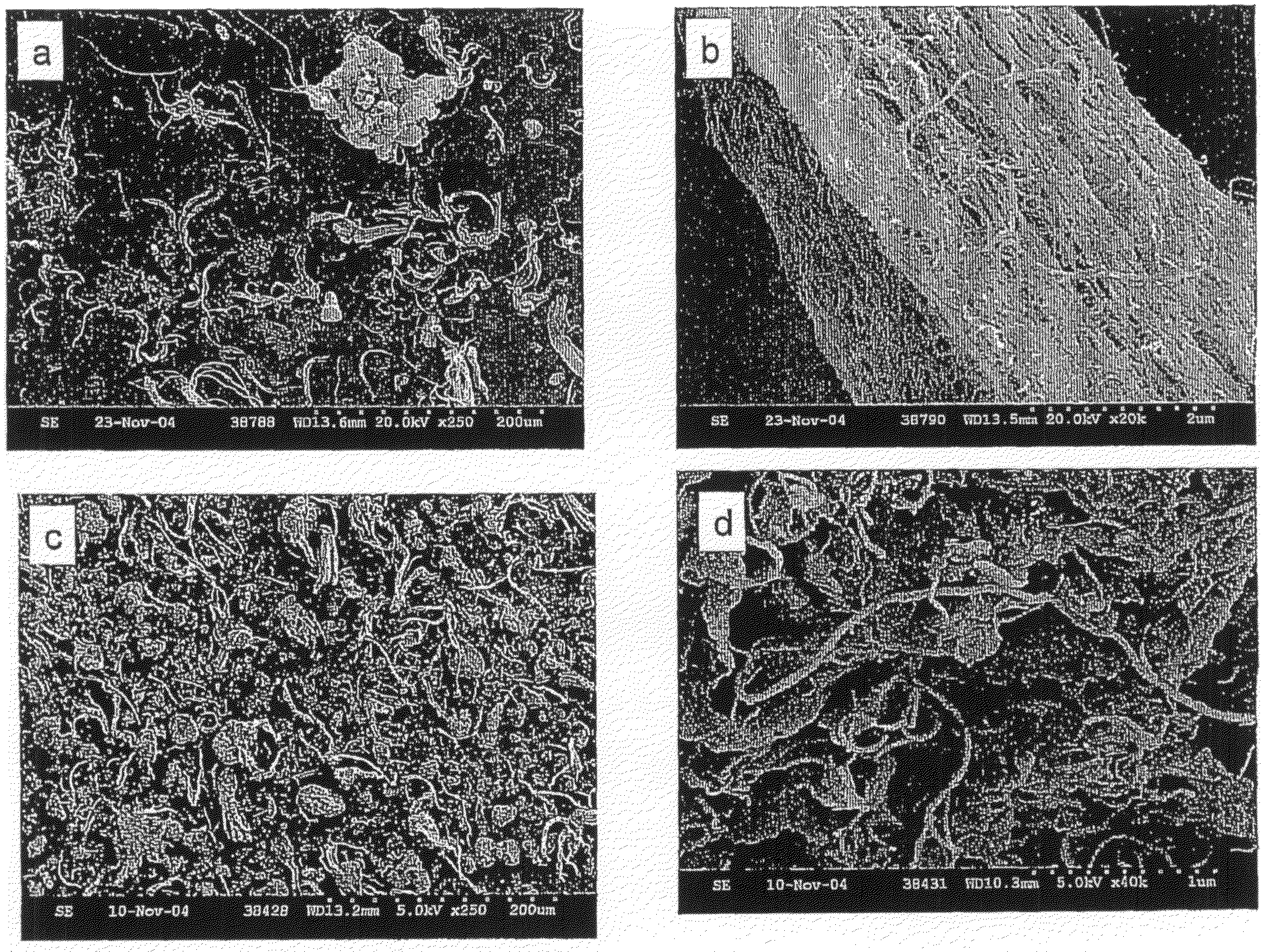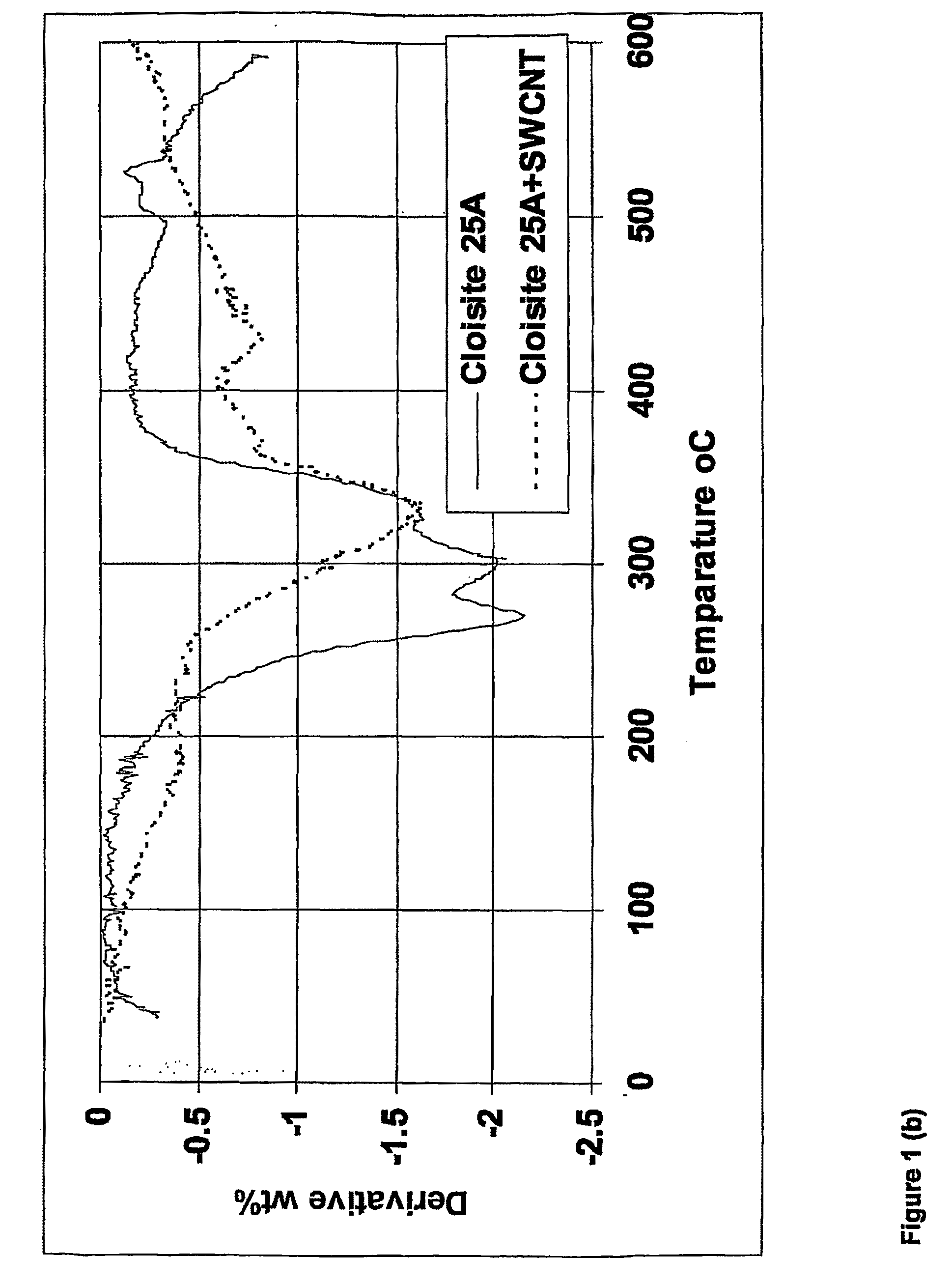Modified Organoclays
a technology of organoclay and polymer matrices, which is applied in the direction of organic conductors, metal/alloy conductors, conductive materials, etc., can solve the problems of only limited compatibility of organoclays with polymers, inferior thermal properties in air atmosphere, and inability to meet the requirements of all-in-one polymer matrices used. to achieve the effect of easy preparation and easy dispersion in polymer matrices
- Summary
- Abstract
- Description
- Claims
- Application Information
AI Technical Summary
Benefits of technology
Problems solved by technology
Method used
Image
Examples
example 1
[0097]Commercially available smectite-type clay [Bentone MA, Elementis specialties, USA] was modified with dimethyl dehydrogenated tallow ammonium chloride (Arquad 2HT-75, a product of Fluka chemicals) by procedure available in the literature [Vaia, R. A.; Teukolsky, R. K.; Gainnelis, E. P. Chem. Mater, 1994, 6, 1017-1022]. The sample is an organoclay which denoted as MA 2HT. 5 g of the organoclay was swollen in 200 ml acetone at room temperature under continuous stirring. 0.5 g of thin multiwall carbon nanotubes obtained from Nanocyl, were dispersed in acetone using high power sonic tip. The resultant nanotube suspension was added to the clay suspension over 30 minutes. After 5 hours high shear mixing at room temperature the entire mixture (MA2HTMWCNT) was transferred into an open tray for the evaporation of solvent at room temperature. After complete drying the solids were milled to fine powders and sieved to uniform size. The thermal stabilities of the modified organoclay are sho...
example 2
[0098]A commercially available smectite-type clay [Bentone MA, Elementis specialties, USA] was dispersed in deionised water at 60° C. at a solids concentration of 0.5-2.0 wt % by shear mixing for 30 minutes to ensure complete delamination of the clay platelets. An aqueous dispersion of multiwall carbon nanotubes [from Nanocyl] in Nanodisperse AQ non-ionic surfactant was added to the clay dispersion over 60 minutes at a nanotube:clay ratio and NanodiperseAQ to clay ratio of 10 wt %. The entire dispersion was mixed at high shear for 30 minutes. An alcoholic solution dimethyl dehydrogenated tallow ammonium chloride (Arquad 2HT-75, a product of Fluka chemicals) was prepared at a surfactant concentration of 5-5.5 wt % was prepared, then slowly added to the clay-nanotube dispersion over 30 minutes. At the end of 3 hr, the solids were decanted, filtered and washed with hot water, then dried at 60° C.). After complete drying the solids were milled to fine powders and sieved to uniform size....
example 3
[0099]The nanotube modified nanoclays MA2HTAQMWCNT were viewed by Scanning Electron microscopy (SEM). FIG. 4 shows the SEM micrographs nanotubes modified nanoclays. The clays modified with nanotubes show clearly the distribution of the nanotubes and opened nanotube bundles throughout the clay
PUM
| Property | Measurement | Unit |
|---|---|---|
| decomposition temperature | aaaaa | aaaaa |
| decomposition temperature | aaaaa | aaaaa |
| decomposition temperature | aaaaa | aaaaa |
Abstract
Description
Claims
Application Information
 Login to View More
Login to View More - R&D
- Intellectual Property
- Life Sciences
- Materials
- Tech Scout
- Unparalleled Data Quality
- Higher Quality Content
- 60% Fewer Hallucinations
Browse by: Latest US Patents, China's latest patents, Technical Efficacy Thesaurus, Application Domain, Technology Topic, Popular Technical Reports.
© 2025 PatSnap. All rights reserved.Legal|Privacy policy|Modern Slavery Act Transparency Statement|Sitemap|About US| Contact US: help@patsnap.com



